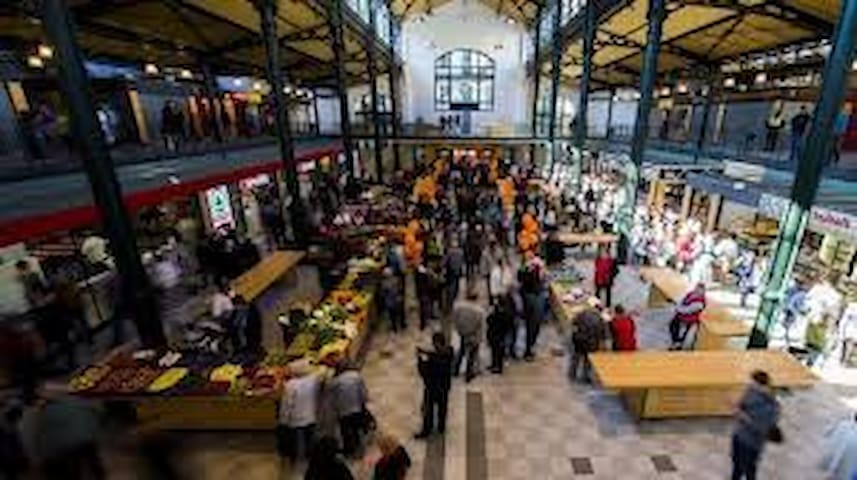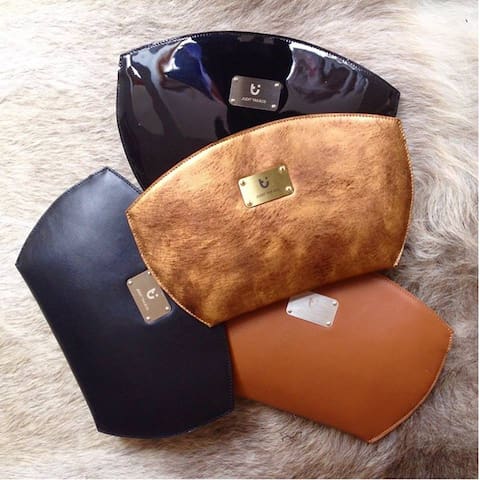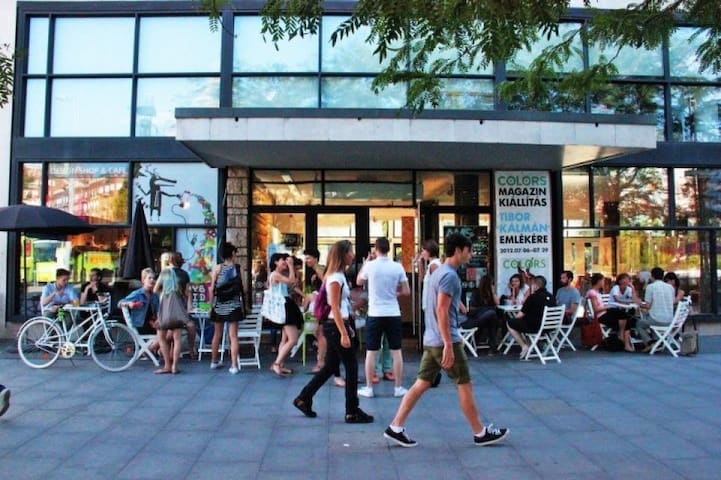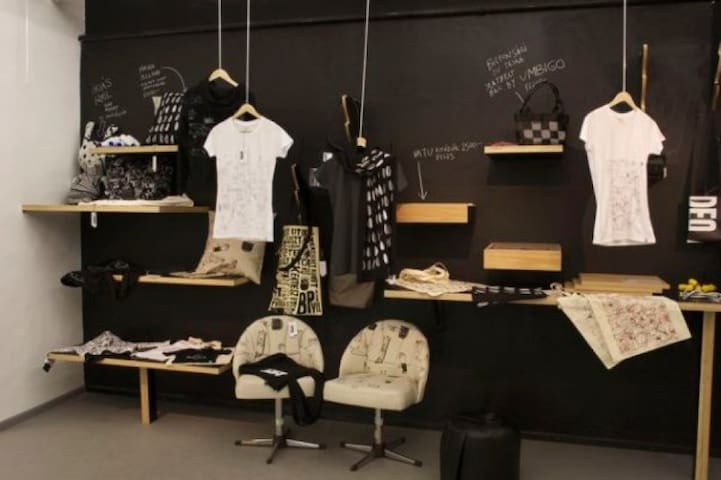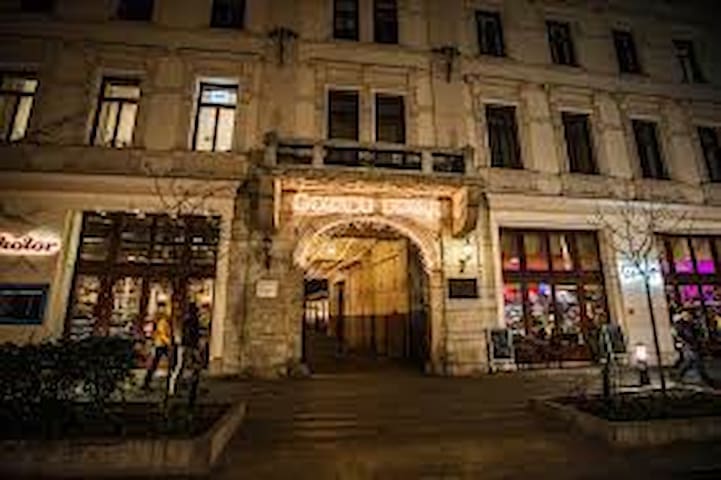Shopping
If you had enough of kitschy souvenirs and if you would like to find something more meaningful and unusual you should visit one of Budapest’s design stores. You would be surprised if you knew what kind of treasures are lying around in these little shops and designer stores – cool pieces of clothing, home accessories, jewellery, candy and sweets. Unexpected and thrilling – be prepared for a stylish journey around Budapest!
The Klauzál Square Market Hall was built in the place of a burned-down theater in 1897, at the period when the capital was suffering from a market hall fever and opened five market halls. The once imposing structure with three hundred retail outlets was renovated in 1987 and then in 2015. This time the city administration dreamed up a hall with new features and spaces, and the plan came true in October. The building is still accessible through the main entrances at Klauzál Square and Akácfa Street, and customers can go to the brand new mezzanine level by stairs, escalator or elevator. In addition to farmers’ tables and display cabinets, numerous catering units, fine bakeries, as well as traditional artisans and suppliers will await customers seven days a week. We highly recommend to try the pancakes on the frist floor.
Tip: If you would like to taste old-fashioned Hungarian pastries, do not miss out on Lúd Cukrászda (Goose Confectionery).
Klauzál tér 11
11 Klauzál térThe Klauzál Square Market Hall was built in the place of a burned-down theater in 1897, at the period when the capital was suffering from a market hall fever and opened five market halls. The once imposing structure with three hundred retail outlets was renovated in 1987 and then in 2015. This time the city administration dreamed up a hall with new features and spaces, and the plan came true in October. The building is still accessible through the main entrances at Klauzál Square and Akácfa Street, and customers can go to the brand new mezzanine level by stairs, escalator or elevator. In addition to farmers’ tables and display cabinets, numerous catering units, fine bakeries, as well as traditional artisans and suppliers will await customers seven days a week. We highly recommend to try the pancakes on the frist floor.
Tip: If you would like to taste old-fashioned Hungarian pastries, do not miss out on Lúd Cukrászda (Goose Confectionery).
Open Showroom unifies the talent of five Hungarian designers and is just a stone’s throw away from the Basilica. In addition to the daring leather-fur clothes and accessories of Anna Arnóczky, we can browse through the rowdy sets of Zoe Phobic, the extreme clothes of Ju Ninelle, the beautiful leather bags of Judit Takacs Design and the whimsical jewellery and smaller leather objects of Timea Talian Designs.
Location: 1051 Budapest, October 6. Street 4.
Opening hours: until December 20. Thursday 3pm – 8pm, Saturday 12pm – 5pm
OPEN Showroom
2., 4 Dolgos utcaOpen Showroom unifies the talent of five Hungarian designers and is just a stone’s throw away from the Basilica. In addition to the daring leather-fur clothes and accessories of Anna Arnóczky, we can browse through the rowdy sets of Zoe Phobic, the extreme clothes of Ju Ninelle, the beautiful leather bags of Judit Takacs Design and the whimsical jewellery and smaller leather objects of Timea Talian Designs.
Location: 1051 Budapest, October 6. Street 4.
Opening hours: until December 20. Thursday 3pm – 8pm, Saturday 12pm – 5pm
Mono is well-known among those who follow Hungarian fashion design. The brand opened a concept store, focused both on visual arts and material culture in the downtown area. It is nearly impossible to leave the store empty-handed, and lately, we can buy more and more products from fresh, up-and-coming brands. The carefully assembled lineup includes nearly everything from sofas and porcelain to clothes and jewellery.
14 íbúar mæla með
MONO art & design
12 Kossuth Lajos u.Mono is well-known among those who follow Hungarian fashion design. The brand opened a concept store, focused both on visual arts and material culture in the downtown area. It is nearly impossible to leave the store empty-handed, and lately, we can buy more and more products from fresh, up-and-coming brands. The carefully assembled lineup includes nearly everything from sofas and porcelain to clothes and jewellery.
ARON DESIGN STORE
Don’t let your office desk become dull and boring, pimp it out with some fresh and wicked stuff. Get yourself some funny post it stickers, coloured pads or anything that you can play with while no one’s watching. Aron Design Store offers all sorts of funny gadgets – not only for your office by the way. Besides writing tools and card holders there are pieces of furniture, kitchen utensils, and games and so on from all around the world. American, British, German and French designs are available just to name a few.
Deák Ferenc tér 4
4 Deák Ferenc térARON DESIGN STORE
Don’t let your office desk become dull and boring, pimp it out with some fresh and wicked stuff. Get yourself some funny post it stickers, coloured pads or anything that you can play with while no one’s watching. Aron Design Store offers all sorts of funny gadgets – not only for your office by the way. Besides writing tools and card holders there are pieces of furniture, kitchen utensils, and games and so on from all around the world. American, British, German and French designs are available just to name a few.
HYBRIDART DESIGN SHOP & CAFE
Hybridart is basically the gift shop of Design Terminál but as the name already suggests, it’s not a typical shop. It’s kind of like a mixture of everything – it’s a design shop, it’s a high-fashion store, it’s a café and it’s also sort of like a bar. It really is like a hybrid of everything that is cool about Budapest. Not to mention the fact that it is situated literally in the heart of the city. There’s always a huge buzz around here, on Erzsébet tér, with all the skater, the fashion junkies, the groupies and the businesspeople. Drop in, get yourself a nice piece of designer accessory – let’s just say, a Judit Takács bag or a ducsaijudit iPhone case – and order a coffee if you’re already there.
135 íbúar mæla með
Erzsébet tér
Erzsébet térHYBRIDART DESIGN SHOP & CAFE
Hybridart is basically the gift shop of Design Terminál but as the name already suggests, it’s not a typical shop. It’s kind of like a mixture of everything – it’s a design shop, it’s a high-fashion store, it’s a café and it’s also sort of like a bar. It really is like a hybrid of everything that is cool about Budapest. Not to mention the fact that it is situated literally in the heart of the city. There’s always a huge buzz around here, on Erzsébet tér, with all the skater, the fashion junkies, the groupies and the businesspeople. Drop in, get yourself a nice piece of designer accessory – let’s just say, a Judit Takács bag or a ducsaijudit iPhone case – and order a coffee if you’re already there.
PRINTA – MULTIFUNCTIONAL DESIGN
The concept behind Printa is based on three key elements: prints, eco-design and education. The shop was established by graphic designer Zita Majoros and photographer Claudia Martinson, who also works with special prints. Printa, on Rumbach Sebestyén utca is situated right next to their own gallery and their café, what’s more they also have a workshop. It offers all sorts of goods made from recycled, environmental-friendly materials; bags, made from safety belts for example. You can also find pieces of revamped furniture and Printa has its very own limited edition collections too.
Rumbach Sebestyén u. 10
10 Rumbach Sebestyén utcaPRINTA – MULTIFUNCTIONAL DESIGN
The concept behind Printa is based on three key elements: prints, eco-design and education. The shop was established by graphic designer Zita Majoros and photographer Claudia Martinson, who also works with special prints. Printa, on Rumbach Sebestyén utca is situated right next to their own gallery and their café, what’s more they also have a workshop. It offers all sorts of goods made from recycled, environmental-friendly materials; bags, made from safety belts for example. You can also find pieces of revamped furniture and Printa has its very own limited edition collections too.
Drinks & Nightlife
Since 2000, so-called ruin pubs have been popping up in an increasing number of these buildings and their inner courtyards. These clubs (e.g. Szimpla, Ellátó kert, Fogasház, Mika Tivadar Mulató, Kőleves kert, and some of Gozsdu Udvar) still enjoy unfaltering popularity.
ruinbars9
From outside, these bars look like normal homes. They don’t have large signs pointing the way, you don’t hear any loud noise, and there’s no line of people waiting to get in. But once you walk in and enter the inner courtyard, you find yourself in the middle of a hip, artsy, and funky bar bustling with crowds talking, dancing, and enjoying the laid-back atmosphere. Large bouncers inside, along with posted signs, ensure that people are quiet on their way out, so as to not disturb the neighbors.
The Gozsdu Udvar (‘Gozsdu Courtyard’) was named after a Romanian lawyer, Manó Gozsdu, known for his real-estate investments. This was one of them. This passageway bearing his name consists of seven buildings and six interconnecting courtyards, and links Király utca with Dob utca. Designed by Győző Czigler, it was opened in 1902, 30 years after Gozsdu had passed away. For much of the 20th century, ownership of his various properties was left in limbo. Neglected until the surrounding Jewish Quarter began to revive from the mid-1990s on, the Gozsdu Udvar remained a bone of contention until an agreement was eventually struck. Slowly, businesses opened up here, but it was until well into the 2000s that there were signs of the current boom. Today, the passageway is mobbed with crowds, crushing into restaurants and bars such as the prominent Spíler, sister operation Spíler Shanghai opposite and Vicky Barcelona. At weekends, a flea market sets up, and Gozsdu has its own escape room, its own Christmas market and its own bouncers at each entrance to the passageway.
600 íbúar mæla með
Gozsdu Court
Gozsdu udvarThe Gozsdu Udvar (‘Gozsdu Courtyard’) was named after a Romanian lawyer, Manó Gozsdu, known for his real-estate investments. This was one of them. This passageway bearing his name consists of seven buildings and six interconnecting courtyards, and links Király utca with Dob utca. Designed by Győző Czigler, it was opened in 1902, 30 years after Gozsdu had passed away. For much of the 20th century, ownership of his various properties was left in limbo. Neglected until the surrounding Jewish Quarter began to revive from the mid-1990s on, the Gozsdu Udvar remained a bone of contention until an agreement was eventually struck. Slowly, businesses opened up here, but it was until well into the 2000s that there were signs of the current boom. Today, the passageway is mobbed with crowds, crushing into restaurants and bars such as the prominent Spíler, sister operation Spíler Shanghai opposite and Vicky Barcelona. At weekends, a flea market sets up, and Gozsdu has its own escape room, its own Christmas market and its own bouncers at each entrance to the passageway.
SZIMPLA KERT
Ask pretty much anyone what they recommend you do in Budapest and they’ll likely suggest a night out at Szimpla Kert. The iconic party place is undoubtedly the city’s most famous nightspot, and has inspired wave after wave of “ruin pubs” that have popped up in the years since it opened.
The initial Szimpla Kert opened way back in 2002 at another spot just a few streets from the current location. But in 2004, a chance presented to move to a bigger building in what was then a relatively quiet spot in the VII District. The building in question, at 14 Kazinczy Street, had housed homes and a factory, but by 2004 lay in ruin. The four Szimpla owners saw opportunities in the building, that was slated for demolition, where others might have only seen dilapidated walls, a tarpaulin where a roof should have been, and not much else. The Szimpla founders thought the “ruin” building was perfect, and this spot has become the epicentre of Budapest’s nightlife.
At night Szimpla Kert is pumping. Some are drinking beer or cocktails while yet others are smoking shisha pipes. It’s crowded. One guy’s even lounging in a bathtub. Yes, a bathtub (and therein lies that charm)! The inner-courtyard is packed and there are people chilling in themed smaller rooms (for example, one is filled with computer monitors showing psychedelic patterns).
The place has grown so popular that some nights there’s a line to get in. This isn’t that pretentious, manufactured kind of line where a bouncer’s only letting certain kinds of people in, it’s just that the capacity has been met. While about 600 people fit, some nights more than 5000 people will rotate through the thick plastic curtain hanging at the door.
21 íbúar mæla með
Kazinczy u. 14
14 Kazinczy utcaSZIMPLA KERT
Ask pretty much anyone what they recommend you do in Budapest and they’ll likely suggest a night out at Szimpla Kert. The iconic party place is undoubtedly the city’s most famous nightspot, and has inspired wave after wave of “ruin pubs” that have popped up in the years since it opened.
The initial Szimpla Kert opened way back in 2002 at another spot just a few streets from the current location. But in 2004, a chance presented to move to a bigger building in what was then a relatively quiet spot in the VII District. The building in question, at 14 Kazinczy Street, had housed homes and a factory, but by 2004 lay in ruin. The four Szimpla owners saw opportunities in the building, that was slated for demolition, where others might have only seen dilapidated walls, a tarpaulin where a roof should have been, and not much else. The Szimpla founders thought the “ruin” building was perfect, and this spot has become the epicentre of Budapest’s nightlife.
At night Szimpla Kert is pumping. Some are drinking beer or cocktails while yet others are smoking shisha pipes. It’s crowded. One guy’s even lounging in a bathtub. Yes, a bathtub (and therein lies that charm)! The inner-courtyard is packed and there are people chilling in themed smaller rooms (for example, one is filled with computer monitors showing psychedelic patterns).
The place has grown so popular that some nights there’s a line to get in. This isn’t that pretentious, manufactured kind of line where a bouncer’s only letting certain kinds of people in, it’s just that the capacity has been met. While about 600 people fit, some nights more than 5000 people will rotate through the thick plastic curtain hanging at the door.
Situated along Klauzál Street, Doboz is the largest party venue and bar of District VII. It was named after a huge, red, box-shaped creation in the venue’s very heart (“doboz” means “box” in Hungarian). The peculiarity of the place is that (as opposed to the ruin pubs of the district) it has a refined interior, while still retaining some of the characteristics of derelict buildings. With its thematized, vast spaces – Grill Terrace, House Party Room, The Saloon – Doboz is truly a sight to behold. You can enjoy pieces of art courtesy of contemporary Hungarian artists, although the main attraction of Doboz is undoubtedly the King Kong sculpture hanging from a tree in the middle of the garden.
226 íbúar mæla með
Doboz - Ruin Pub Budapest
10 Klauzál u.Situated along Klauzál Street, Doboz is the largest party venue and bar of District VII. It was named after a huge, red, box-shaped creation in the venue’s very heart (“doboz” means “box” in Hungarian). The peculiarity of the place is that (as opposed to the ruin pubs of the district) it has a refined interior, while still retaining some of the characteristics of derelict buildings. With its thematized, vast spaces – Grill Terrace, House Party Room, The Saloon – Doboz is truly a sight to behold. You can enjoy pieces of art courtesy of contemporary Hungarian artists, although the main attraction of Doboz is undoubtedly the King Kong sculpture hanging from a tree in the middle of the garden.
If you’re tired of average party places spend a night at Fogas Ház, one of the vanguards of the ruin pub scene in Akácfa utca. This pub has long been a catchment basin for arts and artists, but it was not until 2017 that it reached its current form and popularity. Besides sporting a great name (meaning “House of Teeth“, which derives from a 100-year-old sign found during the initial renovation that advertised denture repair), Fogas Ház also has a stylish interior and budget-friendly prices, plus dance floors to help cure your boogie fever! Lärm, FRAME, Liebling, and Instant are all part of this cool party-complex, so pop in for a night out, and dance until dawn!
743 íbúar mæla með
Instant Club
51 Akácfa u.If you’re tired of average party places spend a night at Fogas Ház, one of the vanguards of the ruin pub scene in Akácfa utca. This pub has long been a catchment basin for arts and artists, but it was not until 2017 that it reached its current form and popularity. Besides sporting a great name (meaning “House of Teeth“, which derives from a 100-year-old sign found during the initial renovation that advertised denture repair), Fogas Ház also has a stylish interior and budget-friendly prices, plus dance floors to help cure your boogie fever! Lärm, FRAME, Liebling, and Instant are all part of this cool party-complex, so pop in for a night out, and dance until dawn!
Ellátó Kert, situated near Kazinczy Street, in the heart of the downtown party district, exudes authentic ruin-pub vibes. In the summer, the place attracts urban cyclists and students thirsty for a cold beer thanks to its open courtyard. No need to worry about cold weather either: a few regulars grew so fond of the place that once the crisp evenings arrived they grabbed hammers and – accompanied by the staff – built a roof atop the garden. They serve Mexican dishes and wide variety of drinks, from fröccs to the locally famous pinky (the latter being a pink grapefruit-vodka shot, a favorite of the place). The yard and the tent are smoking- and dog-friendly.
112 íbúar mæla með
Ellato Kert & Taqueria
48 Kazinczy u.Ellátó Kert, situated near Kazinczy Street, in the heart of the downtown party district, exudes authentic ruin-pub vibes. In the summer, the place attracts urban cyclists and students thirsty for a cold beer thanks to its open courtyard. No need to worry about cold weather either: a few regulars grew so fond of the place that once the crisp evenings arrived they grabbed hammers and – accompanied by the staff – built a roof atop the garden. They serve Mexican dishes and wide variety of drinks, from fröccs to the locally famous pinky (the latter being a pink grapefruit-vodka shot, a favorite of the place). The yard and the tent are smoking- and dog-friendly.
Getting Around
Blaha Lujza tér
Metro 2 (red line)
Klauzál tér
Klauzál tér BUBI bicycle rent
Nyugati Pályaudvar
Keleti Pályaudvar
1051
Metro 1, 2, 3,
Food Scene
Hungary’s capital – and Pest’s District VII in particular – offers plenty of excellent eateries serving traditional and modern dishes. Including plantes of Judaic culture and numerous kosher optionsas well.
Mazel Tov
47 Akácfa u.Stone Soup Inn
Bock Bisztró
43-49 Erzsébet krt.Havana Salsa Bar & Restaurant
57 Dob u.Carmel is in the middle of District VII’s Kazinczy Street, right in the heart of Pest’s Jewish Quarter. They define themselves as a glatt kosher restaurant, which means that they meet the strict requirements of the religion’s kosher requirements entirely. Accordingly, we can find Hungarian and international meals on the menu, but also classical Jewish specialities. There is also a possibility to order a special four-course Sabbath menu (5,000-6,000 HUF), but you can also choose from many à la carte meals too. A good broth (1,400 HUF) with a classic matzo ball in it might be the perfect choice for a starter. Matzo is basically an unleavened bread, the ‘bread of sadness”, and the dumpling made from it is a traditional ingredients of soups.
14 íbúar mæla með
Carmel Étterem
31 Kazinczy u.Carmel is in the middle of District VII’s Kazinczy Street, right in the heart of Pest’s Jewish Quarter. They define themselves as a glatt kosher restaurant, which means that they meet the strict requirements of the religion’s kosher requirements entirely. Accordingly, we can find Hungarian and international meals on the menu, but also classical Jewish specialities. There is also a possibility to order a special four-course Sabbath menu (5,000-6,000 HUF), but you can also choose from many à la carte meals too. A good broth (1,400 HUF) with a classic matzo ball in it might be the perfect choice for a starter. Matzo is basically an unleavened bread, the ‘bread of sadness”, and the dumpling made from it is a traditional ingredients of soups.
Sightseeing
Dohány Street Synagogue
2 Dohány u.Alþingishúsið í Ungverjalandi
1-3 Kossuth Lajos térsynagogue
35 Dob u.Parks & Nature
City Park
Arts & Culture
Ungverska þjóðminjasafnið
14-16 Múzeum krt.Listasafn fallegu listanna
41 Dózsa György útHús hryllingsins safn
60 Andrássy útOpera M station

